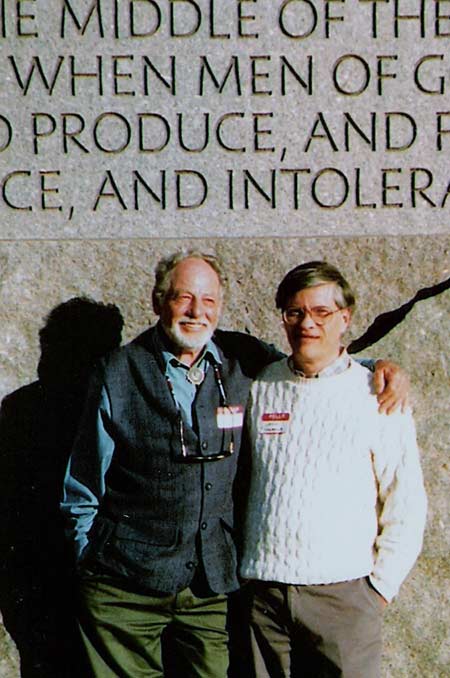by John G. Parsons, FASLA
December 20, 2009

We give thanks for the life of a man who was a creative genius of extraordinary talent and wisdom. He gave us many unique and special places which will be enjoyed by his true beneficiaries, the public and future generations. His life work spanned all scales of Landscape Architecture from city planning to garden design.
His wife, Anna, played a major role in his life. They met at the University of Wisconsin while he was studying horticulture and she modern dance. At her urging, they visited Taliesin, the home and studio of Frank Lloyd Wright where they observed an inscription on the lintel over the entrance, which stated “What a man does, he is.” This became Larry’s credo and it was there that he decided to become a Landscape Architect.
Unlike most Landscape Architects in the 1950’s and 60’s, Larry cared what people thought about the spaces he was designing. He and Anna developed a process, which they called Taking Part where they conducted very effective participatory workshops to seek public input into the design process. Public involvement has now become the norm, but when the Halprin’s started it, it was revolutionary and few designers have perfected it as they did.
As a young Landscape Architect in the late 1960’s, Larry had become my hero although I never expected to meet him. I joined the National Park Service and enjoyed a four-decade career guiding the development of the many parks in the Nation’s Capital. In the early 70’s I was privileged to participate in the selection of Larry to design the Franklin Delano Roosevelt Memorial on the National Mall. This began a long-term relationship between us that resulted in a close friendship.
Larry cared deeply about how people moved through the spaces he created. While contemplating the design of the FDR Memorial, he determined that only a slow-paced, personal experience could transmit the importance of this era to future generations. Thus, he designed the memorial as an experiential history lesson which contains quotations inscribed in granite walls, that he called the pages of the book, multiple sculptural vignettes to tell the story of the President and his times and fountains which reflect FDR’s lifelong involvement with water.
Larry said that, “the FDR Memorial is the apotheosis of all that I have done” and I couldn’t agree with him more. This unique memorial is a perfectly composed sequence of inspiring spaces. The emotional experience, which he created, has caused visitors to return time and again to discover more and enjoy his masterpiece. As a National Memorial, we can all be assured that it will live on in perpetuity.
Larry grew up during the Depression and World War II with “his President”, as he called FDR. He became a life-long Democrat and was often critical of Republicans. Larry confided in me his concern that he might say something disrespectful to President George W. Bush when he presented him with the prestigious 2002 National Medal of the Arts at the White House. I assured him that he couldn’t go wrong with a polite and respectful “Thank you, Mr. President, for this high honor.” He planned to take my advice, but was dumbfounded when the President hung the medal around Larry’s neck and said, “Those are great shoes. I’ve got a pair just like them, but Laura won’t let me wear them in the White House. He couldn’t wait to get out of there before the First Lady saw his shoes.
Larry loved ice cream. During the planning phase of the FDR Memorial, we visited the little White House in Warm Springs, Georgia. While driving through a rural area on our way to the President’s retreat, Larry decided that he had to have a strawberry ice cream cone. Unable to convince him otherwise, I finally detoured into a small town and found a tiny store that, thankfully, had strawberry ice cream. He responded, “I knew you could find it kiddo” and after finishing the cone, he promptly fell asleep for the remainder of the trip.
Larry also had a good sense of humor. While moving through the process for the FDR Memorial, we were constantly plagued by the fact that FDR had told Justice Felix Frankfurter while meeting in the Oval Office that if anyone wanted to build a memorial to him, it should be a small block of granite about the size of his desk. It should be placed in a small triangular park on Pennsylvania Avenue in front of the United States Archives. Family members and friends erected such a memorial there in 1962. Thus, those who were critical of the proposed memorial kept citing his desire for that which was already built. I kept responding that, in America, it is not the individual who determines how they will be memorialized; it is the generations which follow who have had time to evaluate the contribution the person has made to the country. Larry suggested that I change my response by saying that, “I also don’t want a memorial but if they don’t build one for me, I’ll be furious.”
As many of you know, Larry had a basic philosophy of combining life with work. My sense is that when his work ended, he felt the same as George Eastman who said just before his death, “My work is done, why wait.”
God bless you my friend.
Photo: Halprin and Parsons at the FDR Memorial (Photo courtesy John Parsons)